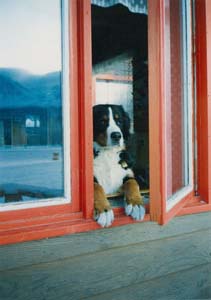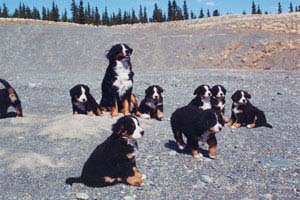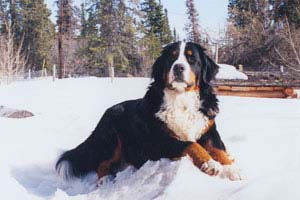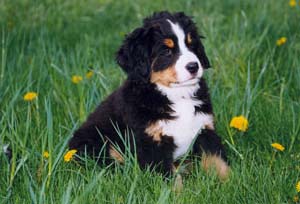Longhaired tricoloured working dog, of above medium size, sturdily built, yet agile; well balanced in all parts.
Size:
Males 64 - 70 cm at withers, ideal size 66 - 68 cm
Females: 58 - 66 cm at withers, ideal size 60 - 63 cm
Self confident, attentive, vigilant, fearless in situations of every day life, good natured and devoted to his own people, self-assured and friendly towards strangers; of average and docile temperament.
Here you can read an Email from Margret Bärtschi. As President of the "Klub für Berner Sennenhunde Schweiz" informed she members of an Emaillist on the history and purpose of the Bernese Mountain Dog (Berner Sennenhund).
This [relationship] is not accidental. It must have to do with a long selection that favoured this dog as an all-round farm and family dog with a strong relationship to all the beings and belongings that earlier composed the centre of a farm in the northern (German) part of Switzerland and southern Germany. So those who [stated] that the BMD was in the first place an all- round farm dog that was able to learn and be trained for special duties are right.
The main duty of Swiss sennenhunde has always been to care for the farm, to recognise any kind of danger, and to protect its inhabitants. He was expected to announce strangers and to keep wild animals, such as wolves, bears, and swine, off the premises.
To understand this, it is necessary to have some knowledge of the history of Switzerland and its inhabitants. Farm- ing on detached places (not in villages) in central Europe started about 400 BC, or even before. That was the time when people started to build their farmhouses and cultivate their fields within the woods, which up to this time covered the hills and plains.


When the Romans occupied Switzerland (they did not invade it!), the original Celtic farmers remained, and with them their livestock and dogs. The Romans never constituted more than 2 to 5 percent of the Swiss (at that time Celtic) population.
The theory that BMDs (and other breeds) were descendants of Roman mastiffs or molossean dogs was created at the end of the last century. At this time, Roman remains (stones!) were detected and the findings published everywhere, whilst the traces of the real inhabitants of many countries had faded away because they had been made of wood. The Roman mastiff theory for BMDs was based on one single dog skull found in the neighbourhood of Vindonissa, which later proved to have been buried there in medieval times, 1,000 years after the Romans had left the country.
Unfortunately, the false story about the Roman origin of the BMD has been copied again and again, and can still be found in older publications.... I'm sorry that not more of the later scientific findings have been published in English. The Swiss sennenhunde are not the descendants of Roman dogs. They were here long before the Romans came!!!
The farm dogs in central Europe (southern Germany, northern Switzerland), where small farms were built individually in the woods, were for centuries first of all the watchdogs and protectors of their farms. They were sometimes used to drive cattle (cows) from one place to another (very easy for a dog to learn), and in some places they were used to pull carts if neces- sary. Since no flocks of sheep (or just small groups of 4 to 10 animals) were in this area, we can conclude that there never was an interest in "herding" for a farm dog.


Certainly, the story about the "weavers" who used BMDs as draft dogs is very strange. Who were they? Weavers as they existed in other parts of Switzerland, where people were too poor to own a dog, did not exist in the Canton of Berne. Why the quotation of these (non-existing) people in connection with the BMD?...
As a final point, concluded from the history of farming in Switzerland and the dogs who were helpers on these farms, we could say: BMDs were all-round farm dogs whose main duty was to protect the farm and its inhabitants (humans and animals) against all kinds of intruders, and who were able to learn other duties, such as driving and pulling small carts. They have always been part of the family, they were able to discern who belonged to the farm or not, and they were expected to be friendly to those whom their masters welcomed, and to keep away those who were strange or had bad intentions.